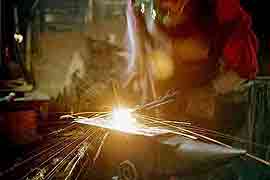For the 2014 Elora Sculpture Project entry, I looked back to a series of sculptural pieces I had developed during 2005 - 2010. This work was inspired by ancient fossil fishes and other sea creatures.
Considering the significance of the Grand River to both the history and the current environment of Elora, a sculptural fish seemed an ideal fit. There is also an obvious link to the limestone that forms the Gorge - and the fossils contained within.

'Armoured Fish' is a fairly large piece, as designed to be the full 48 inches long, with the width at about 12 inches maximum. The forged components are about 48 inches top to bottom, but the main structural support could easily be made any length to raise the sculpture higher up off the standard base mount. (The support member will be welded to a matching piece of 1/8 plate with triangular strengthening brackets.) Despite its large size, the competed sculpture's weight is estimated to be about 50 lbs.
The main components are forged from heavy mild steel, and are being left with their fire scale finish. This will allow these pieces to naturally oxidize as they are exposed to weather. The thickness of the metal ensures a durability measured in decades. In contrast, the various 'fins' are sculpted from stainless steel sheet, providing contrast in both finish and colour. The upper spines are capped with natural wave polished beach stones (limestone from Goderich).
'Shadefish' - illustrates the forging technique intended to be used for the spine element. A heavy 3 x 3/8 flat bar will be drawn to a long taper. Next a series of holes will be hot punched along that length. In between each hole, the bar will be crimped using a shouldering tool.
'Kelp' - illustrates the elements surrounding the main support (three total). Here angle is first flattened, then forged to a series of reversal curves with terminal spirals.
I am quite pleased to have been selected again this year as one of the dozen artists contributing to the 2015 Elora Sculpture Project.
In keeping with the 'water' theme of Armoured Fish, it will be mounted at site #1 which is located at the south side of the bridge.
'Armoured Fish' will be offered for sale - the asking price is $2000.
I am in the process of forging elements for the final assembly of the piece. (Hopefully to be installed this coming Saturday - May 2).
Expect some later postings to detail the process involved.
2103 Contribution - 'Layers'
2014 Contribution - 'Spears of Summer'





























